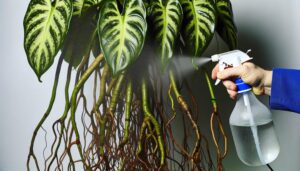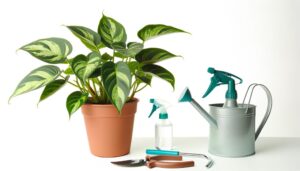How Do I Care for a Philodendron Rojo Congo? Care Guide!
Caring for a Philodendron Rojo Congo requires providing it indirect, bright light and temperatures between 65-85°F. Overwatering can harm it, so allow the soil’s top inch to dry between watering.
A well-draining, peat-based soil mix best caters to its needs. Look out for potential pests – spider mites, mealybugs, aphids, and scale insects.
Repot every 2-3 years, or when the roots outgrow the pot. More in-depth knowledge can further contribute to the health and essentiality of your plant.
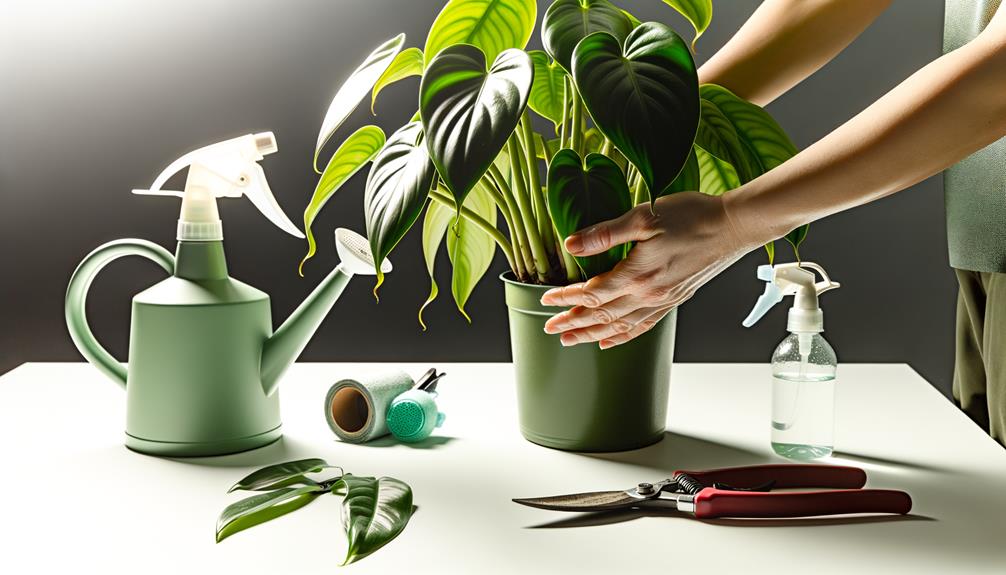
Key Takeaways
- Ensure your Philodendron Rojo Congo receives bright, indirect light, ideally from a northern or eastern-facing window.
- Keep the plant in a stable temperature between 65-85°F to prevent leaf yellowing or scorching.
- Water the plant thoroughly every 1-2 weeks, allowing the top inch of soil to dry between waterings to prevent root rot.
- Use a well-draining, peat-based potting mix that holds moisture but drains excess water quickly.
- Inspect the plant regularly for common pests like spider mites, mealybugs, aphids, and scale insects, using appropriate treatment as needed.
Understanding Philodendron Rojo Congo
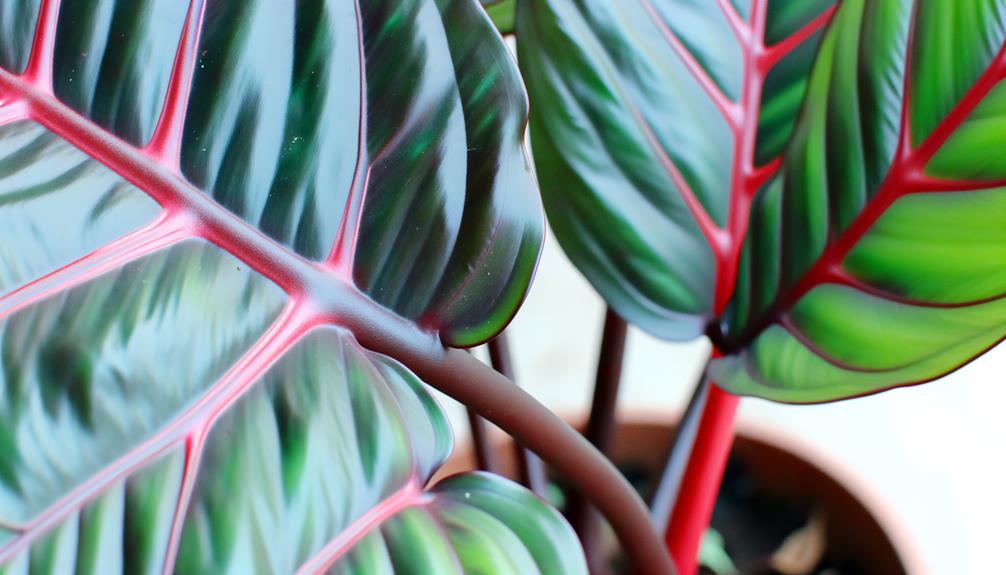
The Philodendron Rojo Congo, characterized by its dark green foliage and vibrant red stems, is a tropical plant native to South America that thrives in warm, humid environments. A member of the Araceae family, it’s low-maintenance, making it a popular choice for indoor gardening.
The plant’s sturdy, glossy leaves add a touch of exotic beauty to any space, while its ability to purify the air contributes to a healthier indoor environment. Ideal growth requires a well-draining soil mix, high humidity, and temperatures between 65°F and 85°F.
Overwatering can lead to root rot, so it’s essential to allow the soil to dry out between waterings. Understanding the Philodendron Rojo Congo’s needs is foundational to providing it with the best care, ensuring it flourishes and enriches its surroundings.
Optimal Lighting for Rojo Congo
For best growth and essentiality, the Philodendron Rojo Congo demands a delicate balance of light; too little can stunt its growth, while too much can scorch its foliage. This tropical plant thrives in bright, indirect light.
A northern or eastern-facing window is an ideal spot, though it can also tolerate lower light conditions. If you notice the leaves turning yellow or brown, it may be getting too much direct sunlight. Conversely, if the growth is sparse and leggy, it might not be getting enough light.
It’s all about monitoring and adjusting the plant’s environment to find the perfect balance. It takes care and attention to detail, but with the right approach, you can keep your Rojo Congo healthy and vibrant.
Ideal Temperature Conditions
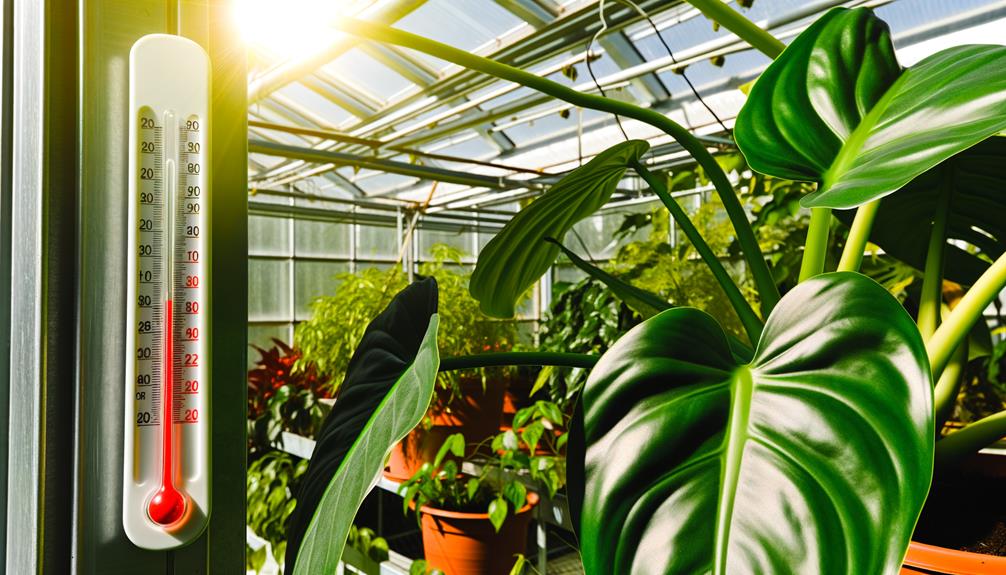
With regards to temperature, Philodendron Rojo Congo prefers a warm and consistent environment, ideally between 65-85°F (18-29°C). This tropical plant thrives in stable conditions where abrupt changes in temperature are minimised.
If temperatures drop below 60°F (15°C), the plant may show signs of distress, such as yellowing leaves or stunted growth. Conversely, temperatures exceeding 85°F (29°C) may cause leaf scorch.
As a caretaker, your mission is to provide a nurturing atmosphere that mirrors the plant’s natural habitat. Indoor settings with controlled temperature are best for the Rojo Congo. Avoid placing it near air vents, heaters, or drafty windows to prevent sudden temperature fluctuations.
Maintaining the ideal temperature range is essential to the plant’s health and well-being.
Watering Your Philodendron Rojo Congo
Just as maintaining the right temperature is fundamental to the health of your Philodendron Rojo Congo, so too is ensuring it receives the correct amount of water. This tropical plant prefers consistently moist soil, but it’s essential to avoid overwatering.
Overwatering can lead to root rot, a common issue with philodendrons. To strike a balance, water your plant thoroughly and allow the top inch of soil to dry out before watering again. This typically means watering once every 1-2 weeks, depending on indoor conditions.
If you notice yellowing leaves, this can be a sign of excess water. Remember, your commitment to providing the right amount of water not only contributes to your plant’s wellbeing but also enhances its aesthetic appeal.
Choosing the Right Soil
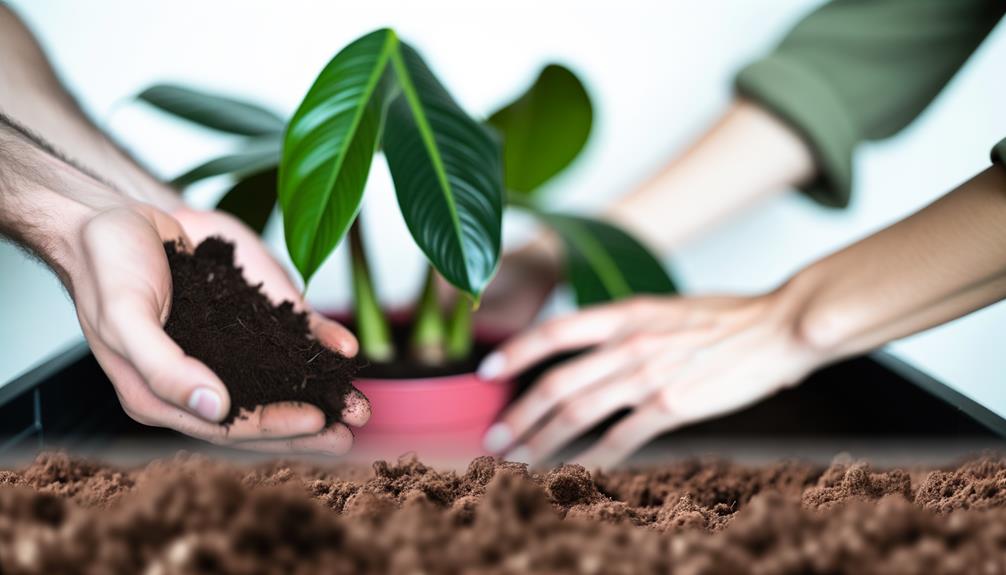
While watering is crucial, selecting the appropriate soil for your Philodendron Rojo Congo is equally important, as it directly impacts the plant’s health and growth.
This tropical plant thrives best in a well-draining, peat-based potting mix. A blend of peat, perlite, and compost creates an ideal environment for your Rojo Congo. Peat, being slightly acidic, helps maintain the pH balance, while perlite enhances drainage, preventing waterlogging and root rot.
The organic matter from compost provides essential nutrients, promoting healthy growth. See to it that the soil is loose and airy; compact soil can lead to poor root development. A good rule of thumb is to choose a soil that holds moisture but drains excess water quickly.
It’s this balance that ensures your Philodendron Rojo Congo flourishes.
Fertilization of Rojo Congo
To promote vigorous growth and vibrant foliage in your Philodendron Rojo Congo, regular fertilization is a necessary aspect of plant care.
A balanced, water-soluble fertilizer, ideally with a ratio of 20-20-20, can be applied monthly during the growing season. This will provide the plant with essential nutrients, particularly nitrogen, phosphorous, and potassium.
However, caution is required to prevent over-fertilization, which can lead to leaf burn. Always follow the manufacturer’s instructions and consider reducing the dosage to half-strength.
In the winter months, as the plant’s growth slows, reduce the frequency of fertilization to every 6-8 weeks. Combining these practices with appropriate watering and lighting conditions will ensure a healthy, flourishing Rojo Congo.
Pruning Your Philodendron
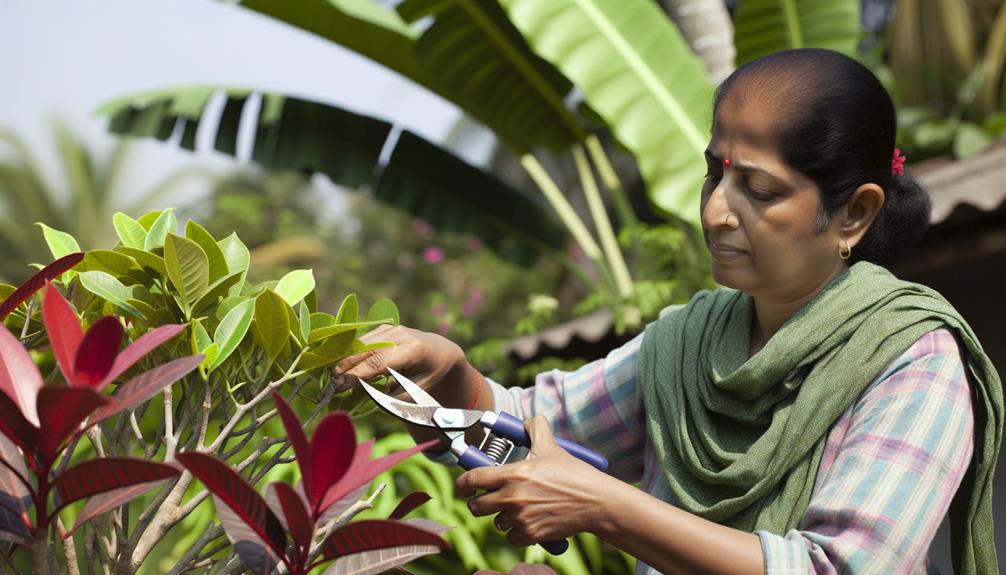
Maintaining the health and aesthetic appeal of your Philodendron Rojo Congo requires periodic pruning. This process involves a careful assessment of pruning needs, execution of appropriate techniques, and diligent post-pruning care.
In the following sections, we will discuss these aspects in detail to assist you in ensuring your plant’s best possible growth and development.
Identifying Pruning Needs
Regular inspection of your Philodendron Rojo Congo will help identify when pruning is necessary, ensuring the plant’s health and best growth.
Pruning needs can be classified into three main categories, each with its unique signs:
- Growth control: If the plant grows vigorously, outgrowing its designated space, it’s time to prune. This will maintain a balanced size and shape.
- Health maintenance: Look for signs of disease or pests, such as discolored, spotted, or chewed leaves. Removing these areas can prevent further spread.
- Aesthetic enhancement: You might want to prune to improve the plant’s overall appearance. Trimming can give it a fuller, bushier look.
Knowing when to prune your Philodendron Rojo Congo is essential to its wellbeing. It’s a significant part of your responsibility in serving its needs.
Pruning Techniques
Implementing the correct pruning techniques is fundamental to the health and aesthetics of your Philodendron Rojo Congo. It can enhance growth, manage size, and prevent disease spread. Pruning should ideally be done in the spring or early summer when the plant is in its active growth period.
Use a pair of sharp, sanitized shears to make clean cuts. Remove any yellow or brown leaves, as well as leggy stems, at their base. This helps maintain the plant’s lush, compact appearance.
Regularly prune long aerial roots that can become invasive. However, be careful not to over-prune, as this can stress the plant.
With a thoughtful, conscientious approach to pruning, your Philodendron Rojo Congo will thrive, showcasing its vibrant foliage and contributing to a serene, inviting environment.
Post-Pruning Care
Following the pruning of your Philodendron Rojo Congo, it is important to provide the plant with attentive post-pruning care to guarantee proper healing and sustained growth.
Here are three key steps to follow:
- Sanitize the Pruning Tools: To avoid the spread of diseases, check that your pruning tools are clean before and after use. This can be achieved by wiping them with a cloth soaked in alcohol.
- Monitor Watering: Post-pruning, the plant will have fewer leaves to lose water through, so adjust watering accordingly. Overwatering can lead to root rot.
- Provide Adequate Light: Ensure the plant receives indirect, bright light. This will support the growth of new foliage while preventing sunburn on the new cuts.
Implementing these measures will optimize your plant’s post-pruning recovery and health.
Dealing With Common Pests
How can one effectively manage common pests that threaten the well-being of a Philodendron Rojo Congo? The first step is to identify the culprit. Common pests include spider mites, mealybugs, aphids, and scale insects.
In order to assist in pest identification and recommend appropriate remedial actions, a table has been included below:
| Pest | Recommended Action |
|---|---|
| Spider Mites | Wash plant with gentle soap and water mixture. |
| Mealybugs | Use cotton swabs dipped in alcohol to remove bugs. |
| Aphids | Introduce ladybugs or use insecticidal soap. |
| Scale insects | Physically remove visible bugs and treat with neem oil. |
It’s essential to act quickly as these pests can cause significant damage if left unchecked. Regular inspection and prompt action will safeguard the health and vitality of your Philodendron Rojo Congo.
Repotting Your Rojo Congo
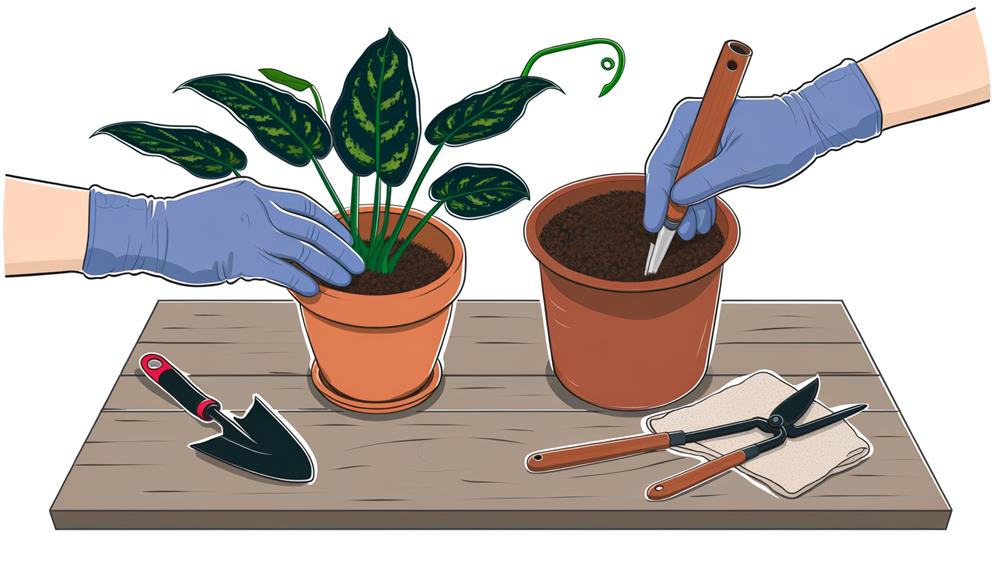
Moving on from pest management, another important aspect of maintaining a healthy Philodendron Rojo Congo is understanding when and how to repot it. Repotting is necessary for these plants every two to three years, or when the roots start to outgrow the pot.
- Choose the right pot: Select a larger pot with good drainage to accommodate the growing root system. Ceramic or plastic pots are suitable choices.
- Prepare the potting mix: A blend of peat moss, perlite, and compost is ideal for Rojo Congo’s growth.
- Transplant the plant: Carefully remove the plant from the old pot, place it in the new one, and fill it with the potting mix. Water thoroughly after repotting.
Conclusion
In sum, diligent care and attention to the specific needs of the Philodendron Rojo Congo will guarantee its peak health and growth.
Just like a well-tuned instrument, this plant requires the right mix of light, temperature, water, and nutrients to truly shine.
Regular pruning, pest control, and timely repotting are also crucial.
With the right care, this plant can become a vibrant, enduring addition to any indoor garden.



